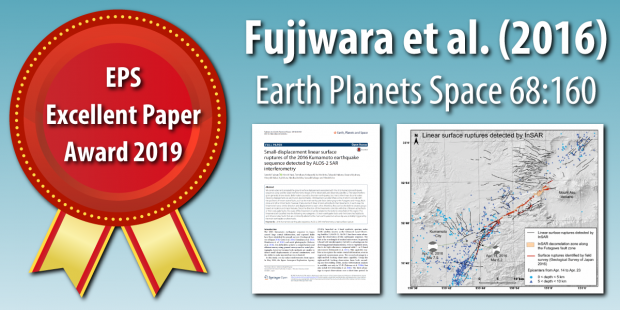- News
- March 31, 2020
EPS Excellent Paper Award 2019

The 2019 EPS Excellent Paper Award is granted to the paper by Satoshi Fujiwara, Hiroshi Yarai, Tomokazu Kobayashi, Yu Morishita, Takayuki Nakano, Basara Miyahara, Hiroyuki Nakai, Yuji Miura, Haruka Ueshiba, Yasuaki Kakiage and Hiroshi Une (2016).
Satoshi Fujiwara, Hiroshi Yarai, Tomokazu Kobayashi, Yu Morishita, Takayuki Nakano, Basara Miyahara, Hiroyuki Nakai, Yuji Miura, Haruka Ueshiba, Yasuaki Kakiage and Hiroshi Une (2016):
Small-displacement linear surface ruptures of the 2016 Kumamoto earthquake sequence detected by ALOS-2 SAR interferometry.
Earth, Planets and Space, 68:160, doi:10.1186/s40623-016-0534-x.
The 2016 Kumamoto earthquake sequence began with an initial earthquake of a moment magnitude (Mw) 6.2 on April 14 (JST), followed by the mainshock with Mw 7.0 on April 16; it lasted for more than a month accompanied by numerous aftershocks. While those earthquakes occurred around the previously mapped active faults, the Futagawa and Hinagu fault zones in central Kyushu, it is important to clarify if and to what extent the associated co- and post-seismic surface displacements were attributable to them. Using satellite radar interferometry (InSAR) images of the Advanced Land Observing Satellite2, Fujiwara et al. (2016) detected approximately 230 linear surface ruptures with small displacements, most of which were outside the main faults and probably triggered by the main earthquake and aftershocks. The detailed images demonstrated the power of InSAR for deformation mapping and contributed to our understanding of the generation of surface faults. Therefore, this paper significantly contributes not only to the advancement of our knowledge of earthquake rupture processes but also to the assessment of the future possible seismic hazards.
Link: Past awardees of the EPS Excellent Paper Award (Springer Open)

![[Frontier Letter] Double difference earthquake location with graph neural networks](https://www.earth-planets-space.org/wp-content/uploads/2025/08/40623_2025_2251_Figa_HTML-1-80x40.webp)
![[Frontier Letter] A new paleomagnetic constraint on the duration of a twin caldera-forming eruption sequence: a potential solution to an enduring problem in decoding >VEI 7 eruption timescales](https://www.earth-planets-space.org/wp-content/uploads/2025/05/40623_2025_2179_Figa_HTML-75x40.webp)
![[Frontier Letter] Balancing of geodetic and seismic moment rates and its implications for probabilistic seismic hazard analysis in Taiwan](https://www.earth-planets-space.org/wp-content/uploads/2025/07/Unknown-1-80x24.png)

